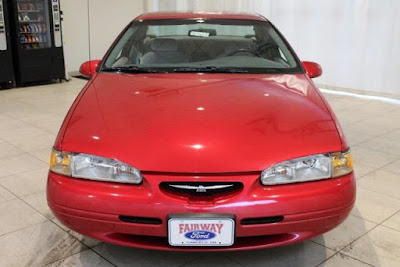I came across this 1997 Ford Thunderbird LX V-8 during one of my recent "cheap car searches" and it really underscores how much the "automobile" has changed over the last twenty years or so; in particular the last decade. Yes, the car as we know it is becoming all but extinct but one of its offshoots that became, for all intents and purposes, extinct more than a decade ago, will in the near future seem as odd as a peculiar dinosaur you see in a museum. How did that thing survive in the wild in prehistoric times anyway?
The Ford Thunderbird and its myriad imitators, Ford invented the personal luxury car segment with their seminal four-passenger, two-door Thunderbird in 1958, survived as long as they did because they appealed to buyers who wanted to make a fashion statement with what they drove. Although far less practical than the sedans they shared platforms and running gear with, they were, for the most part, aesthetically more pleasing as well. For the record, these "tenth generation" Ford Thunderbirds and its Mercury Cougar stable mate, were rather unique in that they utilized a proprietary chassis that wasn't used by any sedan. The 1993-1998 Lincoln Continental Mark VIII used a variation of the chassis as well.
Personal luxury cars were purchased by people who either wanted to be construed as having good taste, didn't have a family, were single and ready to mingle or a combination of all of the above. Rarely was a one purchased because it performed well. Buyers of these cars are "look at me" people and they're fickle as they come. They could just as soon look at this Thunderbird and see it as as their grand parent's car as quickly as they'd say a 1980 hunchback Cadillac Seville was.
These days with young, young at heart and old tastemakers opting for swiss army knife capable crossover sport utility vehicles instead of even sedans, something that's little more than a fashion statement seems as quaint as using a typewriter or only having a flip phone. For someone who grew up with two door cars making splashy styling statements, it takes a fair amount of mental gymnastics for me to understand how something that's first and foremost practical can also be alluring. To me, stylish utility vehicles would be like gym wear that's also appropriate at a wedding.
However, the demise of the personal luxury car began long before the onslaught of crossovers. Well, to be fair, you can still get one today but aside from Buick's absurd "Cascada", and Cadillac's oddly proportioned ATS coupe, you have to go import to get one. And you'll pay dearly for it too. Anyway, as many personal luxury cars as The Big Three may have sold, the meteor that killed them off struck in 1978 when General Motors downsized their intermediate line and that included their personal luxury car lineup. Replacing iconic or moronic designs (depends on your point of view) like the 1973 Chevrolet Monte with a cartoonish knockoff was but one of many mistakes GM has made over the last fifty years. Ford and Chrysler followed suit with debatably as bad or worse downsizing jobs on their personal luxury cars. Just like that, what was once a fashion statement became as outdated as leisure suits. And when gas prices dropped, coupe buyers jumped to trucks.
Ironic then that just as Ford really got it right, the market for personal luxury cars was well on its way to drying up. The MN12 chassis these 1989-1997 Thunderbirds were built on, derided as it was for being heavy, was a robust structure that gave the Thunderbird a rigidity that prior Thunderbird's never had. And with the right engine and suspension tuning, made for a spirited automobile finally worthy of being called, "Thunderbird".
Too bad Ford missed the mark with the design. What was allegedly inspired by the BMW E24 (6 series) came off as a cheap and bland imitation. Extra cladding on the wonderful "Super Coupe", which Ford dropped after 1995, made it more NASCAR hunky but these 1994-1997 LX' lack visceral appeal above and beyond being just a two door car. Again, us coupe buyers are fickle bunch but if a coupe doesn't look marvelous, we'd just as soon drive a four door sedan or, heaven forbid, a cross over.


















































